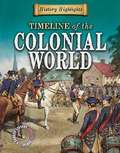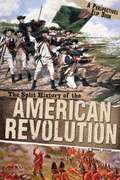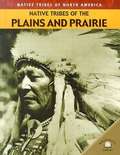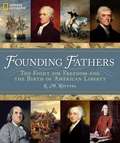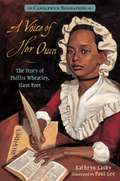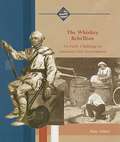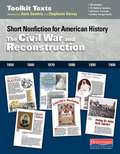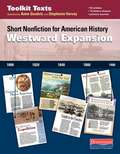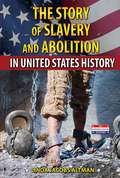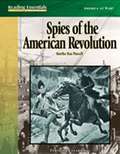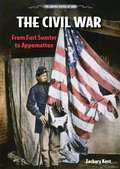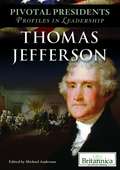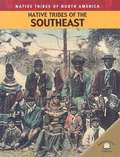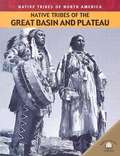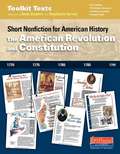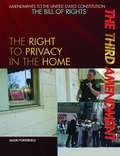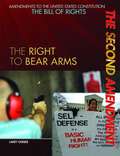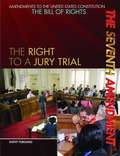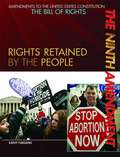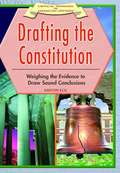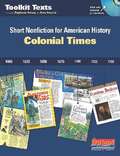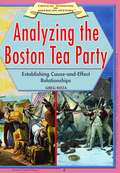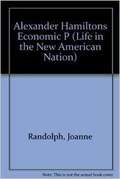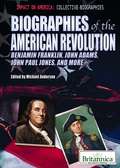Special Collections
District List: NYC Core Curriculum 7th - Social Studies
Description: The New York City Core Curriculum program aims to provide a high-quality curricula to NYC students through a seamless instructional program across grades and subjects. This list has been curated by #NYCDOE for 7th Grade Social Studies materials.
- Table View
- List View
A Timeline of the Colonial World
by Charlie SamuelsChronicles the important events, people, and locations during the Colonial era, including the age of exploration, the settling of North America, the American Revolution, and the colonization of Australia and Africa.
The Split History of the American Revolution
by Michael Burgan and Lawrence Babits and Kathleen Baxter and Robert L. McConnellPeople from Great Britain came to North America to start new lives in the 13 American colonies. In the beginning colonists accepted British rule without question. But by the mid-1700s, things were changing. Many colonists wanted the right to govern themselves. The British government felt as if the colonists were being ungrateful. By 1775 war between the two sides was inevitable.
Native Tribes of the Plains and Prairie
by Michael JohnsonThis series provides a comprehensive reference library on the Native nations and peoples of North America, covering essential information on 400 different tribes. Organized according to traditional geographical and cultural groupings, this collection provides an informative view of the diversity of Native North America, from the Canadian Arctic to the Rio Grande. Each volume features historical photographs, regional maps, historic and updated census information, a guide to prominent museums specializing in Native culture, and a comprehensive index to the tribes featured in all six volumes.
Founding Fathers
by K. M. Kostyal and Jack N. RakoveKostyal tells the story of the great American heroes who created the Declaration of Independence, fought the American Revolution, shaped the US Constitution--and changed the world. The era's dramatic events, from the riotous streets in Boston to the unlikely victory at Saratoga, are punctuated with lavishly illustrated biographies of the key founders--Alexander Hamilton, John Adams, Ben Franklin, Thomas Paine, Thomas Jefferson, George Washington, and James Madison--who shaped the very idea of America. An introduction and ten expertly-rendered National Geographic maps round out this ideal gift for history buff and student alike. Filled with beautiful illustrations, maps, and inspired accounts from the men and women who made America, Founding Fathers brings the birth of the new nation to light.
A Voice Of Her Own
by Kathryn Lasky and Paul LeeIn 1761, a young African girl was sold to the Wheatley family in Boston, who named her Phillis after the slave schooner that had carried her. Kidnapped from her home in Africa and shipped to America, she'd had everything taken from her family, her name, and her language. But Phillis Wheatley was no ordinary young girl. She had a passion to learn, and the Wheatleys encouraged her, breaking with unwritten rule in New England to keep slaves illiterate. Amid the tumult of the Revolutionary War, Phillis Wheatley ultimately had a book of verse published, established herself as the first African American woman poet this country had ever known. She also found what had been taken away from her and from slaves everywhere: a voice of her own.
The Whiskey Rebellion
by Katy SchielWhen Congress enacted a 25 percent excise tax on domestically produced distilled spirits, grain growers and distillers were irate. Especially upset were the small producers of alcohol who began to organize an opposition. When mobs organized an opposition, a tax collector was tarred and feathered and another had his home burned. Shots were exchanged. President Washington called upon the rebels to disperse, but his pleas were ignored. A force of nearly 13,000 men was raised and quelled the opposition, which quickly faded away.
Short Nonfiction For American History
by Anne Goudvis and Stephanie Harvey"We turn information into knowledge by thinking about it. These texts support students in using the Toolkit's comprehension and thinking strategies as tools to acquire and actively use knowledge in history."-Stephanie Harvey and Anne Goudvis
To support cross-curricular strategy instruction and close reading for information, Stephanie Harvey and Anne Goudvis have expanded their Toolkit Texts series to include a library of short nonfiction for American history with 10 all-new Toolkit lessons.
Building on selections from popular children's magazines as well as original articles, these engaging, age-appropriate texts will keep your active literacy classroom awash in historical resources that depict the controversies, issues, and dramas that shaped historical events, including the exploits of lesser-known individuals.
These short nonfiction texts for American history include:
10 comprehension strategy lessons for close reading in content literacy.
Short nonfiction articles on a wide range of topics and at a variety of reading levels.
A bank of historical images, primary source documents and artifacts, plus primary source documents and artifacts bibliographies, web sites, and ideas for online investigations.
A Digital Companion Resource provides all of the texts, primary source documents, and the image bank in a full-color digital format so you can display them for group analysis.
Lesson Title 1 Read and Annotate: Stop, think, and react using a variety of strategies to understand 2 Annotate Images: Expand understanding and learning from visuals 3 Build Background to Understand a Primary Source: Read and paraphrase secondary sources to create a context for a topic 4 Read and Analyze a Primary Source: Focus on what you know and ask questions to clarify and explain 5 Compare Perspectives: Explore the different life experiences of historical figures 6 Read Critically: Consider point of view and bias 7 Organize Historical Thinking: Create a question web 8 Read with a Question in Mind: Focus on central ideas 9 Surface Common Themes: Infer the big ideas across several texts 10 Synthesize Information to Argue a Point: Use claim, evidence, and reasoning
The CCSS and other state standards expect that children will read a variety of texts on a common topic and synthesize the ideas and information.
These short nonfiction texts were selected using the following criteria: Interest/Content Because kids love the quirky and the unexpected, these texts highlight important but often lesser-known or unrecognized perspectives and voices from the past. Visual literacy Since visual literacy is an essential 21st-century skill, these texts include historical images, paintings, and maps, as well as diagrams, timelines, charts, and photographs. Writing quality and accuracy To foster student engagement, these articles feature vibrant language in an active voice supported by a rich assortment of visual features. Reading level/complexity These texts are written at a range of reading levels and include a wide variety of topics to capture the interests of all readers.
Short Nonfiction For American History
by Stephanie Harvey and Anne Goudvis"We turn information into knowledge by thinking about it. These texts support students in using the Toolkit's comprehension and thinking strategies as tools to acquire and actively use knowledge in history."-Stephanie Harvey and Anne Goudvis
To support cross-curricular strategy instruction and close reading for information, Stephanie Harvey and Anne Goudvis have expanded their Toolkit Texts series to include a library of short nonfiction for American history with 10 all-new Toolkit lessons.
Building on selections from popular children's magazines as well as original articles, these engaging, age-appropriate texts will keep your active literacy classroom awash in historical resources that depict the controversies, issues, and dramas that shaped historical events, including the exploits of lesser-known individuals.
These short nonfiction texts for American history include:
10 comprehension strategy lessons for close reading in content literacy. Short nonfiction articles on a wide range of topics and at a variety of reading levels. A bank of historical images, primary source documents and artifacts, plus primary source documents and artifacts bibliographies, web sites, and ideas for online investigations. A Digital Companion Resource provides all of the texts, primary source documents, and the image bank in a full-color digital format so you can display them for group analysis.
The Story of Slavery and Abolition in United States History
by Linda Jacobs AltmanTraces the history of slavery in the United States, focusing on the abolition movement and the final steps that freed an enslaved people.
Spies Of The American Revolution
by Martha Sias PurcellExplains the purpose of spies during the American Revolution and describes the actions of several spies including Nathan Hale, General Benedict Arnold, Emily Geiger, and Patience Lovell Wright.
The Civil War
by Zachary KentThe Civil War, the bloodiest conflict in American history, forced neighbor to fight neighbor and brother to fight brother. More Americans lost their lives in this conflict than in any other war. From the hallowed battlefield at Gettysburg to the surrender at Appomattox, author Zachary Kent explores this pivotal time in American history, when a nation on the brink of destruction was reunited and permanently rid of slavery.
Thomas Jefferson
by Michael AndersonAs skilled at architecture and inventing as he was at politics, Thomas Jefferson was a man of many talents who was invaluable to the founding of the United States. After loaning his expertise to writing the Declaration of Independence, Jefferson went on to serve as the third U.S. president, nearly doubling the size of the United States during his term. Jeffersons extraordinary life and accomplishments are recounted in this engaging volume.
Native Tribes of the Southeast
by Michael Johnson and Duncan ClarkeAn introduction to the history, culture, and people of the many Indian tribes that inhabited the region along the south Atlantic coast of the United States, around the Gulf of Mexico, and west to the Mississippi River.
Native Tribes of the Great Basin and Plateau
by Michael Johnson and Duncan ClarkeAn introduction to the history, culture, and people of the many Indian tribes that inhabited the region of the present states of Utah and Nevada and the mountainous area of the northwest United States and southern British Columbia in Canada.
American Revolution And Constitution
by Stephanie Harvey and Anne Goudvis52 short nonfiction texts for American History (1750-1800) with 10 new lessons for content literacy
"We turn information into knowledge by thinking about it. These texts support students in using the Toolkit's comprehension and thinking strategies as tools to acquire and actively use knowledge in history." -Stephanie Harvey and Anne Goudvis
To support cross-curricular strategy instruction and close reading for information, Stephanie Harvey and Anne Goudvis have expanded their Toolkit Texts series to include a library of short nonfiction for American history with 10 all-new Toolkit lessons.
Building on selections from popular children's magazines as well as original articles, these engaging, age-appropriate texts will keep your active literacy classroom awash in historical resources that depict the controversies, issues, and dramas that shaped historical events, including the exploits of lesser-known individuals.
These short nonfiction texts for American history include:
10 comprehension strategy lessons for close reading in content literacy. Short nonfiction articles on a wide range of topics and at a variety of reading levels. ( 45 articles in Colonial Times and 52 articles in The American Revolution and Constitution ) A bank of historical images, primary source documents and artifacts, plus primary source documents and artifacts bibliographies, web sites, and ideas for online investigations. A Digital Companion Resource provides all of the texts, primary source documents, and the image bank in a full-color digital format so you can display them for group analysis. Lesson Title 1 Read and Annotate: Stop, think, and react using a variety of strategies to understand 2 Annotate Images: Expand understanding and learning from visuals 3 Build Background to Understand a Primary Source: Read and paraphrase secondary sources to create a context for a topic 4 Read and Analyze a Primary Source: Focus on what you know and ask questions to clarify and explain 5 Compare Perspectives: Explore the different life experiences of historical figures 6 Read Critically: Consider point of view and bias 7 Organize Historical Thinking: Create a question web 8 Read with a Question in Mind: Focus on central ideas 9 Surface Common Themes: Infer the big ideas across several texts 10 Synthesize Information to Argue a Point: Use claim, evidence, and reasoning The CCSS and other state standards expect that children will read a variety of texts on a common topic and synthesize the ideas and information.
These short nonfiction texts were selected using the following criteria: Interest/Content Because kids love the quirky and the unexpected, these texts highlight important but often lesser-known or unrecognized perspectives and voices from the past. Visual literacy Since visual literacy is an essential 21st-century skill, these texts include historical images, paintings, and maps, as well as diagrams, timelines, charts, and photographs. Writing quality and accuracy To foster student engagement, these articles feature vibrant language in an active voice supported by a rich assortment of visual features. Reading level/complexity These texts are written at a range of reading levels and include a wide variety of topics to capture the interests of all readers.
The Third Amendment
by Jason PorterfieldThe Third Amendment guarantees that soldiers cannot be quartered with U.S. citizens during times of peace. At the time of its passage, this amendment made a significant difference in the lives of American citizens. It formed a separation between Americas military and its civilians. Although seldom cited today in court cases, the Third Amendments impact has been long lasting, and has given rise to military bases all over the country. This book richly explores the amendment and its history. Fascinating sidebars and photographs support the text.
The Second Amendment
by Larry GerberThe United States has the most guns per capita of any country in the world. Many Americans value the right to bear arms, which they believe is guaranteed by the Second Amendment to the Constitution. Others believe that the Second Amendment only guarantees the right for organized militias to own guns. This book surveys the history of the Second Amendment and gun ownership in the United States, and explores how the amendment continues to affect us today.
The Seventh Amendment
by Kathy FurgangWhile jury trials in criminal cases are recognized as vitally important to safeguarding the Constitutional rights of the accused, the right to a jury trial in civil cases is a less understood, celebrated, and valued right. This book is an invaluable reminder of just how important the Seventh Amendment is to the promotion and preservation of fairness and justice in America. By entrusting a jury of ordinary and impartial citizens to decide the outcome of lawsuits, the framers of the Constitution and Bill of Rights removed the power from the judges, who could potentially be swayed and corrupted. The Seventh Amendment levels the playing field, guaranteeing that a citizen's voice and interests carry as much weight as that of a wealthy individual, major corporation, or powerful government. The historical context that motivated the drafting and passage of this amendment is discussed, as is the evolution of civil law, jury trials, and the application of the Seventh Amendment in American history, from colonial times to the present. Contemporary, straight from the headlines cases-including Toyota's recent woes-illustrate the relevance of the Seventh Amendment and its application to cases involving consumer protection, environmental cleanup, medical malpractice, and corporate wrongdoing.
The Ninth Amendment
by Kathy FurgangOne of the more elusive and nebulous of Constitutional amendments, the Ninth Amendment essentially guarantees unnamed and unspecified individual rights not explicitly enumerated within the Constitution or the other amendments. From its ratification, the amendment has caused confusion and uncertainty. Even Supreme Court justices have been unsure how to interpret it and unclear about exactly what individual rights it extends to American citizens. The vagueness of the amendments wording has discouraged many people from basing their claim to a specific right on the Ninth Amendment. This book penetrates the veil of mystification that surrounds the amendment and explains exactly why it was proposed and ratified, and why it was worded in the way it was. It shows how consensus about how to interpret and apply the amendment has very gradually emerged through the course of several landmark Supreme Court Cases. Indeed, the story of the Supreme Court's grappling with the Ninth Amendment provides a window onto some of the most seminal and iconic moments in American history, including New Deal politics, labor activities, fair housing laws, and past and current hot-button issues of privacy.
Drafting The Constitution
by Kristin EckThis book is a substantial, stand-alone history of the drama and debate that went into the drafting and ratification of the U.S. Constitution. It offers an in-depth examination of the state of the new American nation after the Revolution; the fatal weaknesses in the Articles of Confederation; the growing clamor to draft a new plan of government; the impassioned debate between the big and small states; the rocky road to compromise; and the ratification of our government s founding the document.
Colonial Times
by Stephanie Harvey and Anne GoudvisThese short nonfiction texts for American history include:
10 comprehension strategy lessons for close reading in content literacy.
Short nonfiction articles on a wide range of topics and at a variety of reading levels.
( 45 articles in Colonial Times and 52 articles in The American Revolution and Constitution )
A bank of historical images, primary source documents and artifacts, plus primary source documents and artifacts bibliographies, web sites, and ideas for online investigations.
A Digital Companion Resource provides all of the texts, primary source documents, and the image bank in a full-color digital format so you can display them for group analysis.
Analyzing The Boston Tea Party
by Greg RozaUsing the exercises and primary source documents in this engaging book, students will learn about key moments that led to the American Revolution.
These include the financial pressure on England after its resources were spread thin by the French and Indian War, the formation of the Sons of Liberty, the backlash and revolt of colonists in response to the Stamp, Sugar, and Quartering Acts, the tea party itself, and the eventual meeting of the first Continental Congress.
Alexander Hamilton's Economic Plan
by Ryan P. RandolphAlexander Hamilton's Economic Plan: Solving Problems in America's New Economy
Biographies Of The American Revolution
by Michael AndersonA captivating series that surveys the lives of the political figures and social revolutionaries who shaped early U.S. history includes vibrant images depicting memorable events and individuals, a glossary, explanations of key terms and ideas, and relevant websites and organizations to consult for further reference.
